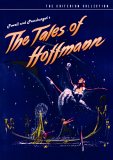Synopsis
Three of E.T.A. Hoffmann’s fantastic tales were made into an opera by Jacques Offenbach, and that opera was in turn transformed into this 1951 film by Michael Powell and Emeric Pressburger. Robert Rounseville takes the lead as a fictional version of Hoffmann himself. While pining after a ballerina, whose love is being stolen from him by an evil aristocrat, he spins three tales of unrequited and doomed love, where in he falls in love first with an automaton, then a soul-stealing (literally) c…urtesan, and then with a consumptive singer. Light as the music often is, and explosively colourful as the fantastic sets are, there is still a lot of darkness in the film, as befits the subject matter (the automaton story, for instance, is based on “The Sandman,” possibly Hoffmann’s creepiest tale). An entirely sung film won’t find favour with every audience, but this is a very effective transposition to cinema (it isn’t stagy at all), and is a visually unique work of art.
Audio
The sound is mono, in keeping with Criterion’s purist approach. No doubtful remixes here, thank you very much. The sound is very clear, and almost completely free of distortion. This is particularly nice in the case of the vocals, which come through with well-nigh perfect clarity. This is a very rich mono, and if I have a quibble, it’s that the volume is a bit low (turn on the commentary, and you’ll suddenly have to turn the volume down).
Video
Mixed feelings here. On the one hand, the print is in close to pristine conditions. There is no speckling, and no damage at all, barring a couple of barely visible guitar strings. There is no grain at all (miraculous, given the age of the film), and the colours are almost blinding. So far, so fabulous. The problem involves the edges, and I’m hard pressed to know whether to blame the source material or the transfer. At any rate, red and green outlines proliferate, often quite severely (imagine watching a 3D movie without the glasses), which hurts the otherwise fine level of sharpness. The result is often distressingly blurry. There is also some red bleeding into the blacks.
Special Features
Historian Bruce Eder and Martin Scorsese share the commentary track. The former handles the production of the film, the latter the actual filmmaking techniques, not to mention his own personal memories of seeing the movie. Both speakers are first-rate. Also very cool is an interview with George Romero, another fan from childhood, and he has some pretty intelligent contributions to make as well. There are three still galleries (stills, posters and lobby cards, and production designer Hein Heckroth’s sketches and paintings), and these galleries have explanatory labels, something that happens all too rarely. The theatrical trailer is here, as well as a short feature by Powell: “The Sorcerer’s Apprentice,” which is in much the same vein as the main film. The liner also has an excellent essay by Ian Christie. The menu’s main screen is scored and is subtly animated.
Closing Thoughts
A fascinating release, with great extras, but a picture with a few issues.
Special Features List
- Audio Commentary
- George A. Romero Interview
- Still Galleries
- “The Sorcerer’s Apprentice” Short Film
- Theatrical Trailer
- Liner Notes






